Master of the Banderoles
Playing Cards by the Master of the Banderoles, one of the earliest professional printmakers.

Playing Cards by the “Master of the Banderoles”
Der Meister mit den Bandrollen
The Master of the Banderoles - so-called because of the banderoles (speech banners) present in many of his prints - originated in the North Netherlands during the mid-fifteenth century and lived in the east of the Netherlands between Zwolle and Bocholt ca. 1462-1500. He (or she) was one of the earliest professional printmakers. Most of his output consisted of devotional and decorative images for the emerging market for prints which would have been pasted onto boards or into books. He tended to copy subjects from other sources whilst building up a composition, or reuse his own motifs, rather than create original works.
Right: detail from 'Fortune and Death' by the Master of the Banderoles, c.1450-1475
showing a banderole or scroll containing 'speech' emanating from a King →
Working almost within living memory of the first arrival of playing cards into Europe, the Master of the Banderoles’ set of playing cards provide a rare glimpse into their early development. Some of the Master's work was based on Italian models, so it is possible that he was influenced by or had visited Italy. These eight cards appear to be from an Italian (or Spanish)-suited pack of at least 48 cards, although no Aces or court cards are present in the fragment. The cards have been engraved in sequential order and are separated by a single line.

Above: an uncut sheet of eight playing cards probably the work of the Master of the Banderoles, an artist who is supposed to have worked on the Lower Rhine about 1470. The designs suggest Italian inspiration. Height of sheet: 192 millimetres; Width: 270 millimetres. ©The Trustees of the British Museum. All rights reserved.


The Master of the Banderoles produced religious and devotional images as well as subjects such as grotesque alphabets and these playing cards. He worked in the new medium of engraving which required draughtsmanship and technical ability for copying the works of existing masters. The cross-over between religious and profane images is evident in the cup suit symbols which are in fact ciboria, cups for holding hosts from the Christian Eucharist and presumably ‘sacred’, similar to the chalices used for wine. The Master of the Banderoles seems to be very familiar with their designs. They were usually made of precious metal, or plated with silver, and possibly decorated with engraving. Ciboria were sometimes kept at homes to be handy for the Last Rites where needed. The impish little figures - ‘putti’ - cavorting amongst the ciboria add a slightly irreverent sense of fun and playfulness to the playing cards, consistent with their use as a recreational game.
Cherubs and ‘Putti’, which started reappearing in medieval art during the 15th century, were distinct. Cherubs were Angels and thus close to God. Putti were associated with Eros/Cupid and profane love and used as decorative art on buildings, frontispieces and illuminated capital letters. The Master of the Banderoles entertainingly merges spiritual and secular themes in his pack of playing cards by placing ‘putti’ amongst the ciboria.


Similar antics can be seen in the miniature figures adorning the numeral cards in another elaborate Italian or Spanish-suited, Gothic pack of playing cards, produced in South Germany, which appears to commemorate the marriage, in 1496, of Felipe I of Spain and Doña Juana, daughter of Ferdinand and Isabella more →

Right: Ace of Batons and Six of Cups from the pack of cards by the South German Engraver showing children cavorting amongst the pip symbols, late 15th century.
Left: Aces of Cups & Coins from a Gothic Spanish-suited pack produced in Spain, late 15th / early 16th century decorated with small children playing around the suit symbols.
← In addition, there is another Gothic Spanish-suited pack with naked children gamboling in the numeral cards, produced by woodcuts rather than engraving, believed to have been made in Spain around the same time.
The practice of decorating playing cards with small naked figures, or ‘putti’, persisted for several centuries in many Spanish and Italian-suited cards. In the Baroque period the putto came to represent the omnipresence of God. see example →
Bibliography and References:
Lockhart, Anne I.: Four Engravings by the Master with the Banderoles, The Bulletin of the Cleveland Museum of Art, Vol. 60, No. 8 (Oct., 1973), pp. 247-254
Acknowledgements: thanks to Samten de Wet for kind assistance with research.
I would suggest an Italian origin for these ideas - which permeated through Venice to Augsburg, Nuremberg, and the so-called Northern German Renaissance - which had as its climatic fruition, the work of Durer. Warburg scholars have paid attention to this field, and even for example, Durer made versions of the so-called Tarot of Mantegna. The classical research for this imaginal world can be traced back to Cyriacus of Ancona. These are a few bones of thought . . . Samten

Above: detail of gothic woodcarving in walnut wood on the choir stalls in Plasencia cathedral, Spain. Nudity could represent the purity and innocence associated with childhood. In the playing cards it might allude to the unpredictability of fortune in the game.
By Simon Wintle
Spain • Member since February 01, 1996 • Contact
I am the founder of The World of Playing Cards (est. 1996), a website dedicated to the history, artistry and cultural significance of playing cards and tarot. Over the years I have researched various areas of the subject, acquired and traded collections and contributed as a committee member of the IPCS and graphics editor of The Playing-Card journal. Having lived in Chile, England, Wales, and now Spain, these experiences have shaped my work and passion for playing cards. Amongst my achievements is producing a limited-edition replica of a 17th-century English pack using woodblocks and stencils—a labour of love. Today, the World of Playing Cards is a global collaborative project, with my son Adam serving as the technical driving force behind its development. His innovative efforts have helped shape the site into the thriving hub it is today. You are warmly invited to become a contributor and share your enthusiasm.

Related Articles
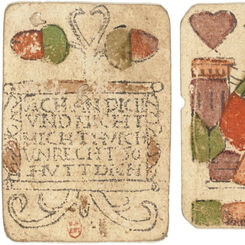
Early German playing cards
Some early examples of popular German playing cards from the XV and XVI centuries.
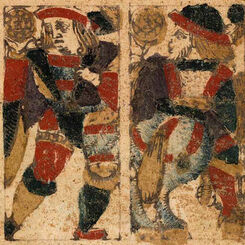
Toledo, 1584
Archaic Spanish-suited deck with 48 cards made in Toledo in 1584.
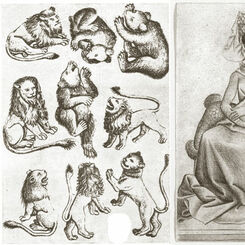
Master of the Playing Cards
Animal suited playing cards engraved by the Master of the Playing Cards, Germany, c.1455

Carel de Wagenaer
Facsimile edition of cards first published by Carel de Wagenaer, Amsterdam in c.1698
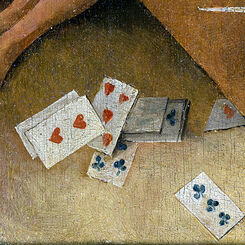
Hidden meanings in painting by Jheronimus Bosch
Medieval View of Gambling in the ‘Garden of Earthly Delights’ by Jheronimus Bosch
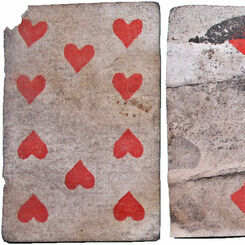
Archaeological find: old playing cards under the floorboards
The municipal archaeological service in Dordrecht (Netherlands) recently found some antique playing ...
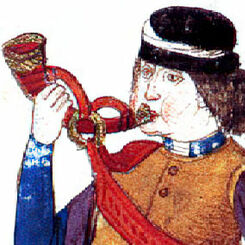
Flemish Hunting Deck
Set of medieval playing cards with King, Queen, Knave and numeral cards from one to ten in each of f...
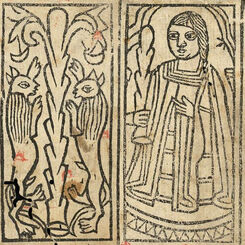
XV Century Catalan playing cards
XV Century Catalan Playing Cards, featuring four female Sotas, four Aces and four cards from the sui...
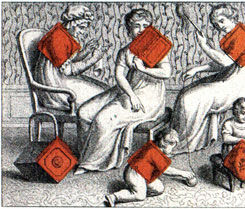
Cotta Transformation playing cards
In 1804, J.G. Cotta, a publisher and bookseller in Tübingen, Germany, produced the first set of tran...

Malta
The so-called ‘Dragon Cards’, with winged monsters on the four Aces, are an enigmatic aspect of earl...
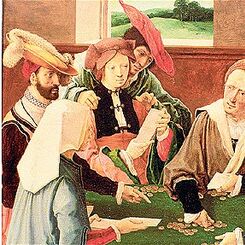
Netherlands
Playing cards have been known in the Low Countries since the 14th century
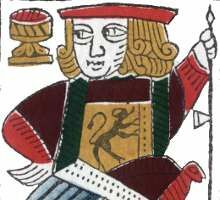
Navarra, XVII Century
Facsimile of 17th century Spanish-suited playing cards produced by Erregeak, Sormen S.A., Vitoria-Ga...

Gothic Spanish-suited cards
These cards may be a typical example of early 'standard' Spanish playing cards, maybe from before Co...

Phelippe Ayet, c.1574
Archaic, late medieval Spanish-suited playing cards printed by Phelippe Ayet, c.1574.
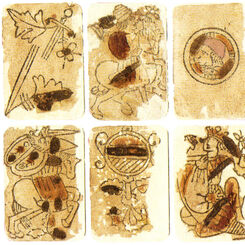
Baraja Morisca — Early XV century playing cards
Primitive Latin suited pack, dated by paper analysis as early XV century, which makes this one of th...
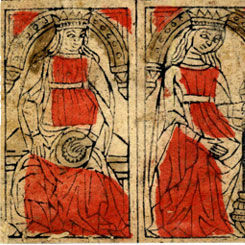
XV Century Italian Playing Cards
Cards from a pack of an early form of north Italian playing cards, with the swords back-to-back and ...
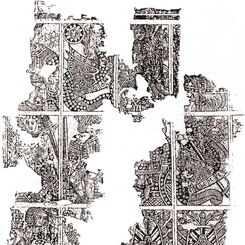
Early Spanish/Portuguese type
Fragment of a sheet of archaic Spanish-suited 'Dragon' playing cards found during restoration of a h...
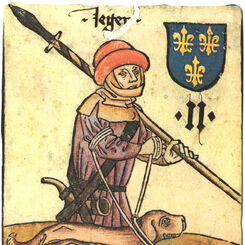
Hofamterspiel, c.1460
Hofamterspiel, c.1460
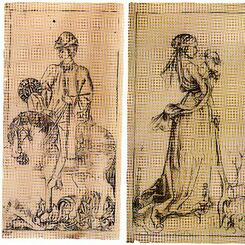
Early German Engraved Playing-cards
During the second half of the fifteenth century, with printing technology commercially established a...

South German Engraver
A pack of 52 cards with banner 10s, female 'Sotas', horsemen and kings, the pack was engraved in the...
Most Popular
Our top articles from the past 60 days






















